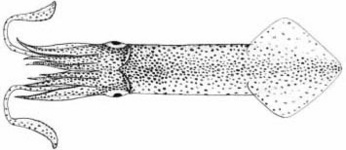Doryteuthis (Amerigo) gahi
Patagonian squid
Michael Vecchione and Richard E. YoungCharacteristics
- Mantle
- Mantle moderately elongate.
- Fins
- Fins rhomboidal, short, their length about 40 to 45% of mantle length.
- Arms
- Arms elongate, especially ventral and ventrolateral.
- Arm sucker rings with 6 or 7 broad, flat teeth in distal half, proximal half smooth.
- Left ventral arm hectocotylized in dista1 1/3: suckers on dorsal row greatly reduced in size and set on elongated, triangular, swollen pedicles that grade smaller distally; ventral row unmodified.
- Tentacles
- Tentacles long, slender.
- Clubs narrow, unexpanded, with relatively small suckers on manus.
- Median suckers about 2 times the diameter of the marginal suckers
- Teeth on club sucker rings pointed, very numerous: 25 to 35 (possibly 45).
Habitat and Biology
Occurs from the surface to 350 m depth but usually only to 285 m. The greatest numbers of juveniles were consistently caught in waters of <100 m to the south and east of East Falkland. Most D. gahi juveniles aggregate close to the sea floor.
Inshore spawning sites of D. gahi were found in the waters of East Falkland (Southwest Atlantic), where there is a major fishery based on this species. Egg masses occurred in algal beds, often at the outer (seaward) edge, with ambient water temperatures of 6.5-9 C. Egg strands were attached to the kelp algae Lessonia spp. and Macrocystis pyrifera from 0.5 m to 2.5 m off the bottom at 8-20 m depths. The capsules are mainly 50-60 mm in length and contain an average of 70 fertilized eggs. Eggs laid in winter are significantly larger than those laid in summer.
Doryteuthis gahi increase in size and maturity with depth. Immature and fully mature squid were found at depths less than or equal to 100 m. The data support the hypothesis that this species spawns in shallow water and migrates down the continental shelf and continental slope after hatching. It then returns to shallow water to spawn. Highest concentrations of squid appeared to occur at depths and in areas where the commercial fishery operates.
Geographic Distribution
Eastern Pacific Ocean from southern Peru to southern Chile; reported in the South Atlantic from the Gulf of San Matias, Argentina to Tierra del Fuego. The northern limits on both coasts are unknown.
Other Names for Doryteuthis (Amerigo) gahi
- Synonymy: Loligo patagonica.
- Vernacular Names: En: Patagonian squid, Fr: Calmar patagon, Sp: Calamar patagónico, Local species names: Argentina, Chile, Peru: Calamar
About This Page
Michael Vecchione

National Museum of Natural History, Washington, D. C. , USA
Richard E. Young

University of Hawaii, Honolulu, HI, USA
Correspondence regarding this page should be directed to Michael Vecchione at
vecchioneM@si.edu
Page copyright © 2010
 Page: Tree of Life
Doryteuthis (Amerigo) gahi . Patagonian squid.
Authored by
Michael Vecchione and Richard E. Young.
The TEXT of this page is licensed under the
Creative Commons Attribution-NonCommercial License - Version 3.0. Note that images and other media
featured on this page are each governed by their own license, and they may or may not be available
for reuse. Click on an image or a media link to access the media data window, which provides the
relevant licensing information. For the general terms and conditions of ToL material reuse and
redistribution, please see the Tree of Life Copyright
Policies.
Page: Tree of Life
Doryteuthis (Amerigo) gahi . Patagonian squid.
Authored by
Michael Vecchione and Richard E. Young.
The TEXT of this page is licensed under the
Creative Commons Attribution-NonCommercial License - Version 3.0. Note that images and other media
featured on this page are each governed by their own license, and they may or may not be available
for reuse. Click on an image or a media link to access the media data window, which provides the
relevant licensing information. For the general terms and conditions of ToL material reuse and
redistribution, please see the Tree of Life Copyright
Policies.
- First online 02 September 2010
- Content changed 02 September 2010
Citing this page:
Vecchione, Michael and Richard E. Young. 2010. Doryteuthis (Amerigo) gahi . Patagonian squid. Version 02 September 2010 (under construction). http://tolweb.org/Doryteuthis_%28Amerigo%29_gahi/52724/2010.09.02 in The Tree of Life Web Project, http://tolweb.org/









 Go to quick links
Go to quick search
Go to navigation for this section of the ToL site
Go to detailed links for the ToL site
Go to quick links
Go to quick search
Go to navigation for this section of the ToL site
Go to detailed links for the ToL site